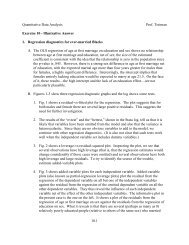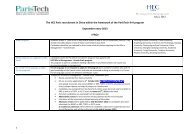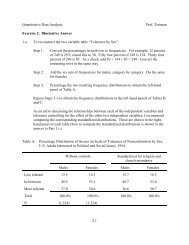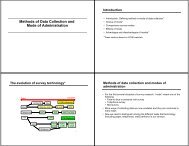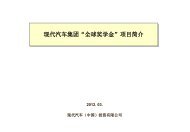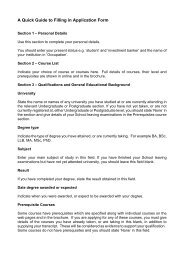Notes on Poisson Regression and Some Extensions
Notes on Poisson Regression and Some Extensions
Notes on Poisson Regression and Some Extensions
Create successful ePaper yourself
Turn your PDF publications into a flip-book with our unique Google optimized e-Paper software.
logT | (offset)------------------------------------------------------------------------------The baseline rate of premarital birth is exp(−4.937) = 0.007 or about 7 premarital births perthous<strong>and</strong> per year of age (after age 11). This event is exp(1.557) = 4.74 time higher for womenover the age of 20. The comparis<strong>on</strong> category for race is Hispanic, so we find rates that are about58% lower for whites <strong>and</strong> about 2.34 times higher for blacks at any age (relative to Hispanics).Because the rates are proporti<strong>on</strong>ally higher or lower depending <strong>on</strong> the values of the covariates inthe model, this model is referred to as a proporti<strong>on</strong>al hazards model.Exercise 7: Using the table above, fit a model that allows the risk to vary by race depending <strong>on</strong>age. That is, fit a model in which there are n<strong>on</strong>proporti<strong>on</strong>al effects of race <strong>and</strong> determine if thereis evidence of n<strong>on</strong>proporti<strong>on</strong>ality.Hazard Models with Cluster-level Frailty We can combine ideas from the previoussecti<strong>on</strong> to model for events. Suppose we c<strong>on</strong>sider a sampling plan that records age at firstpremarital birth for the subsample of white women in the NLSY. The NLSY includes resp<strong>on</strong>dents<strong>and</strong> up to 6 sibling resp<strong>on</strong>dents in the data. We can use this data structure to illustrate multilevelhazard rate models. Durati<strong>on</strong>, t ij denotes the age at first premarital birth for the ith individualin the jth family. The event-status indicator d ij = 1 denotes a premarital birth at time t ij for theith individual in the jth family. A proporti<strong>on</strong>al hazard model accounting for cluster-level frailty ish(t ij ) = h 0 (t ij ) exp{x ij (t ij )β}v j ,where we assume that v j follows a gamma distributi<strong>on</strong> with mean 1 <strong>and</strong> variance φ = 1/α asbefore. The model can be estimated using the EM-algorithm, which treats v j as a known relativerisk. At each EM iterati<strong>on</strong>, our estimate of v j is updated using current results from a loglinearmodel (Poiss<strong>on</strong> regressi<strong>on</strong>) <strong>and</strong> our current estimates of α as follows:̂v j = ̂α + d +ĵα + H +jwhere d +j is the total number of events in the jth cluster <strong>and</strong> H +j is the sum of the integratedhazards in the jth cluster. The imputed frailties from each iterati<strong>on</strong> are then treated as part ofthe “offset” term in a Poiss<strong>on</strong> regressi<strong>on</strong>. The model can also be estimated directly using ML <strong>and</strong>a Poiss<strong>on</strong> regressi<strong>on</strong> model for panel data (xtpois) in Stata.Stata Example Script.set memory 5000#delimit;infile v1 intr v3 d ts tf v7 cid c9 n<strong>on</strong>intm12 m13 mmed mwrk14 adjinc msinc nsibs southurban fundpro cathol weekly profam selfest test using 6W1.dat;gen offs=log(tf-ts);gen a1 = intr==1;gen a2 = intr==2;gen a3 = intr==3;gen a4 = intr==4;gen a5 = intr==5;19



